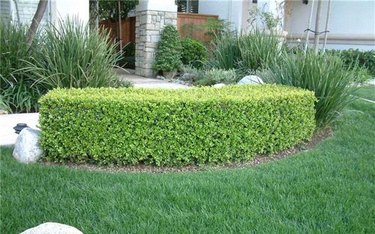Japanese boxwood (Buxus microphylla var. japonica) works well in hedges or foundation plantings. Growing a healthy shrub begins at planting. Once established, Japanese boxwood needs some ongoing care, but the plant is not high-maintenance. This evergreen shrub grows 6 to 8 feet wide and 10 to 15 feet tall with a compact growth habit. Japanese boxwood is a perennial in U.S. Department of Agriculture (USDA) plant hardiness zones 6 through 9.
Sun, Spacing, and Soil Requirements
Video of the Day
Plant Japanese boxwoods 3 feet apart in a row to create a hedge. For a more informal planting, stagger boxwood shrubs, leaving at least 3 feet between them. Fall and spring are the best times to plant new shrubs. In mild climates where winter frosts are light, you can plant at any point throughout the winter.
Video of the Day
Pick a planting spot out of the wind in full sun to part shade. Boxwood will grow in full shade, but growth will be slowed by the lower light. Japanese boxwood grows best in loamy soil that drains well.
Planting Japanese Boxwood
Planting a Japanese boxwood shrub is a cinch, but there are a few things to keep in mind:
- Wearing gloves, use a shovel to dig a hole the same depth as the boxwood's root ball and twice as wide.
- Picking the shrub up by the base, remove it from the nursery pot and set it in the hole. You want the plant positioned in the hole so that the top of the root ball is level with the surface of the soil.
- If necessary, dig the hole deeper or add soil to the hole until the plant is level.
- Next, tamp (pat down) the soil you dug out of the hole around the root ball, filling in any holes and air pockets as you work.
- Bring the soil up to the base of the trunk, being careful not to mound soil around the trunk higher than surrounding grade.
- Use soil you excavated from the hole to fill in, rather than organic matter or amendments. The latter can cause drainage problems in the soil.
Water Effectively
Water Japanese boxwood right after planting so the soil is damp 12 inches deep. Using a soaker hose allows the water to enter the soil slowly, which gives it a chance to seep down to the roots. Dampen the soil from the base of the trunk out past the outer branch tips.
For the first two years, water weekly during dry weather if there's no rainfall, especially in summer. Water enough each time to dampen the soil 12 inches deep. Once the shrub is established, you can extend watering to 10-day intervals during dry weather.
Mulch the Soil
Mulch the area under boxwoods with a 1- to 2-inch-deep layer of compost, bark, pine straw, or other organic mulch material.
- Spread the mulch starting 1 to 2 inches from the base of the trunk out to 12 inches past the outer leaves.
- The mulch should not touch the plant's trunk.
Fertilize in Spring
Fertilize Japanese boxwood early in spring, just before you see new green growth, according to soil-test results. In the absence of a soil test, use a balanced 10-10-10 fertilizer.
- Measure out 1 1/2 cups of fertilizer for a 10-by -10 foot area, or 100 square feet.
- Sprinkle the fertilizer on the soil evenly, starting 6 inches from the base of the trunk and extending out to the area under the outer branch tips.
- Water the area well after spreading the fertilizer.
Trimming and Shearing
If needed, trim or shear Japanese boxwood in the spring after the last expected frost date in your area.
- Use a pair of hedge clippers to prune boxwood into a formal hedge or rounded shape.
- Before clipping Japanese boxwood, prevent the spread of disease by sanitizing your hedge clippers.
- Before making each cut, wipe the blades with alcohol.
Pest Identification and Treatment
Japanese boxwood is one of the more pest-resistant members of this shrub group, but that doesn't make it immune to problems. Two pests to look out for are boxwood leafminer and boxwood mites.
Boxwood leafminer features larvae that feed inside leaves. Symptoms include blistering, raised areas and brown tunnel-like markings on leaves. In summer, the adult leafminers, which are pale red, flylike insects, lay eggs.
Tip
Control boxwood leafminer by pruning out any affected branches and destroying them as soon as you see signs of larvae, generally in spring. This keeps the population down. Also keep boxwood leafminers in check by encouraging predatory insects, such as garden spiders.
Boxwood mites are tiny sap-sucking insects that feed on the undersides of leaves. Look under a magnifying glass and you'll see tiny, tan insects that affect leaves by creating brown flecks or marks on the leaf surfaces.
Tip
Control boxwood mites by spraying the entire shrub with diluted insecticidal soap. Mix 4 teaspoons of concentrated insecticidal soap with 1 quart of water in a spray bottle. Shake it up and spray directly on the mites.
When using insecticidal soaps, keep in mind that while they're less toxic than some chemical pesticides, they are nonetheless pesticides. Wear gloves, long sleeves and eye protection. Spray on a windless day and avoid spraying beneficial insects like bees.
